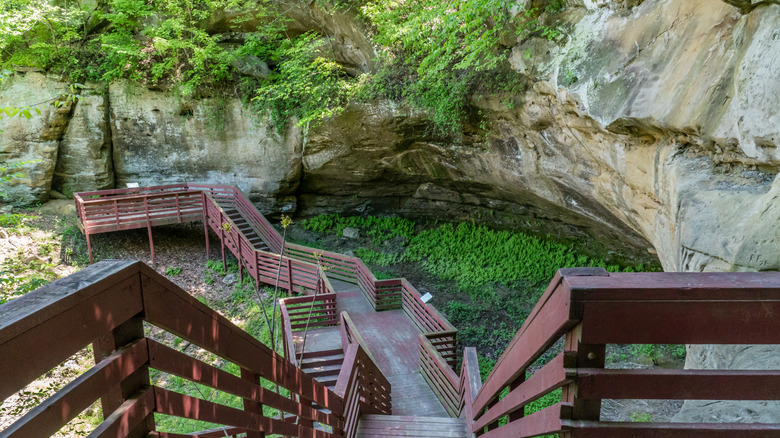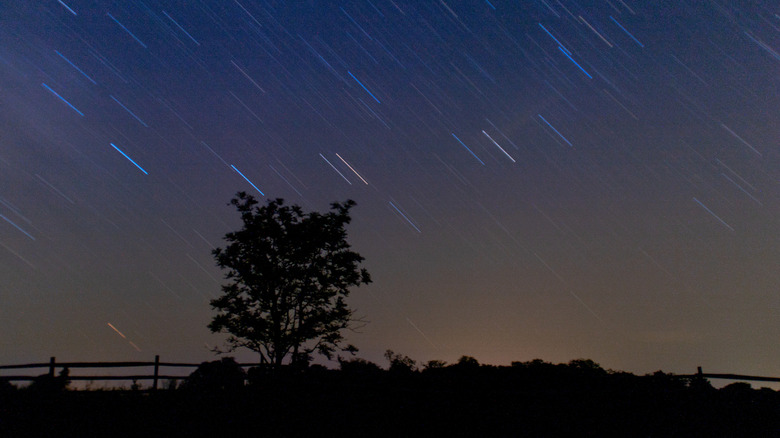Nebraska's State Park On The Missouri River Has A Giant Cave, Backcountry Camping, And Prehistoric Petroglyphs
America's vast Great Plains have a strong claim to the title of "most underappreciated region of the United States." Even experienced travelers often regard the region as little more than farmland and flat emptiness, good for little more than flying over en route to East and West Coast destinations. However, overlooked Great Plains states like Nebraska do have treasures to share with diligent travelers. Nebraska's gorgeous Niobrara National Scenic River is one of the quietest places on Earth, with scenic cliffs and amazing trails to match its peaceful aura. More modern novelties await in places like Nebraska City and its whimsical treetop village, bouncy bridges, and slides. If you're looking for an unsung park site that protects both natural beauty and historical treasures, Nebraska's amazing Indian Cave State Park ranks among the best in the entire Midwest.
Located about an hour and a half south of Omaha, along Nebraska's eastern border with Missouri, Indian Cave State Park sits atop a beautiful stretch of the epic Missouri River, defined by serene hardwood forests and geology that's much more intricate than you'd expect from the flat Great Plains. Indian Cave's woodlands and expansive views make for superb picnic spots and sightseeing hikes, but the park's main draw is the sizable sandstone cave from which it gets its name. While Indian Cave is not a true "cave" in the technical sense, its towering rock formations are just as awe-inducing as even the largest subterranean cavern systems. As if monumental views weren't enough, Indian Cave also bears some of the best prehistoric petroglyphs in both Nebraska and the U.S. as a whole.
Indian Cave State Park showcases Nebraska's lesser-known natural and cultural treasures
As far as natural attractions go, caves tend to be something of a mixed bag for many travelers. On the one hand, cave systems offer intricate rock formations and an eerie aesthetic rarely found above the surface. On the other hand, a cave's dark and often cramped spaces may induce unpleasant claustrophobia in some visitors (or might simply creep them out). However, Nebraska's Indian Cave offers the best of both worlds in terms of underground and aboveground features.
Indian "Cave" is not actually a true cave at all, but rather a large sandstone overhang that creates something of a natural rocky "roof" over the park's riverside woodlands. This allows Indian Cave to offer visitors the same dramatic geological experiences of fully underground cave systems, without forcing them to abandon the sunlight or the spectacular views of the landscape around them. Indian Cave State Park also has an ADA-accessible boardwalk that gives visitors up-close views of Indian Cave on one side and spectacular shots of the Missouri River landscape on the other.
Alongside its impressive geological spectacle, Indian Cave also features a priceless collection of prehistoric petroglyphs (cave drawings) carved by ancient Indigenous peoples who inhabited the area centuries before European contact. Though experts are still unclear on exactly how old these carvings are, or which specific group of people made them, Indian Cave's petroglyphs are a living testament to the long and rich human history of the Great Plains. Though the park doesn't get the attention given to national parks further west, Indian Cave State Park is nevertheless one of the most awe-inspiring places to see ancient rock art in the United States.
Indian Caves ranks among the best outdoor destinations in the Great Plains
In addition to the namesake cave and ancient rock art, Indian Cave State Park's 3,000+ acres contain eye-catching bluffs and hills rolling along the banks of the Missouri River. With such a picturesque setting, Indian Cave State Park is one of Nebraska's top-tier destinations for scenic hikes. The cave, cave art, and magnificent Missouri River scenery are all accessible on the park's 22 miles of excellent hiking trails. Many of these trails loop along the park's main sights, so you can choose any number of hiking routes and still get close access to the cave and its rock art panels.
Horse lovers will also appreciate Indian Cave's 16 miles of equestrian trails, where you can experience the park's immense beauty and cultural significance on horseback. The park also has a reservable picnic shelter, an outdoor amphitheater, an archery range, and even a disc golf course! Aspiring ornithologists can take advantage of the park's status as one of Nebraska's top spots for bird watching, with excellent opportunities to see native bird species like woodpeckers, tanagers, warblers, and flycatchers, among others.
Indian Cave State Park is excellent for day trips, but it's also one of Nebraska's top state parks for overnight camping. The park currently has two main campgrounds, both of which are equipped with cozy modern amenities and camper-friendly infrastructure. The park's Ash Grove Campground includes 36 Electric and 51 Electric Plus campsites, while the Hackberry Hollow Campground has 15 Electric and 32 Electric Plus sites. Both sites also include access to showers, modern restrooms, grills, sewer hookups, picnic tables, fire pits, water hydrants, and even laundry facilities! If you've brought your hoofed friend, you can both stay overnight at one of Indian Cave's equestrian campsites.


